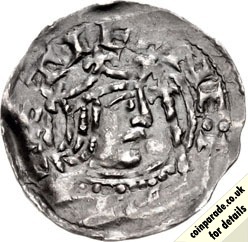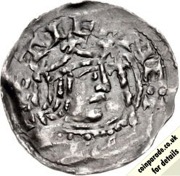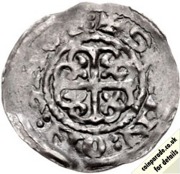
 The 1136-1145 Penny - Stephen
The 1136-1145 Penny - StephenSilver Penny of King Stephen, minted around 1136-1145 at the Nottingham Mint of Moneyer Sveinn.
Diameter 21mm, weight 1.47g. SCBC: 1286. North: 925/1.
The Obverse shows a crowned bust facing right holding a lis-tipped sceptre. Legend is party defaced by the mint. Later they would also erase part of the dies due to the demands of the civil war when old dies were re-used.
 The Reverse shows a cross moline (a Christian cross that is a cross with the end of each arm forked and recurved). Part of the coin erased like the obverse was.
The Reverse shows a cross moline (a Christian cross that is a cross with the end of each arm forked and recurved). Part of the coin erased like the obverse was.Coin shown graded as Good VF.
Image credit: CNG Coins
List items on:
Mintage: Rare
Minted at Provincial mints.
Stephen (1135-1154)
Classification: Norman Kings, House of BloisStephen, also known as Stephen of Blois, was King of England from 22 December 1135 until his death on 25 October 1154 (aged 57-62). Born in 1092 or 1096 Blois, Kingdom of France. He married Matilda I, Countess of Boulogne.
Most of King Stephen's reign was dominated by The Anarchy, which was a civil war between England and Normady, mainly about succession wher he fought again his cousin the Empress Matilda (also known as Empress Maud). Peace only came after they agreed that Maud's son (Henry II) would succeed Stephen.
Category: Penny
The Penny is one of the most famous British coins. The coin itself has been around since 600AD and at various times has been struck in silver, copper and bronze. Originally split into halfpennies and farthing, it is now itself the least denomination coin currently in circulation. Made from copper (actually copper plated steel). Originally there were 12 pennies in one shilling and 240 pennies in £1; since decimalisation in 1971 there are 100 new pence in one pound.
Composition: Early pennies were Silver, then Copper, Bronze and Copper coated steel.
Which Mint: Provincial mints
Not all mints are located in a single place. From the Roman days through to the middle ages it was easier to have local moneyers (trusted people who were allowed to mint coins) rather than make the coins centrally and then have the security and logistics problem of distribution.There were often dozens of mints, sometimes all making the same coin. The variations and mintmarks are exciting for numismatists, although sometimes it takes an expert to analyse them.
Most English Provincial Mints began to close after 1279 when the Royal Mint opened The Tower Mint (called so as it was housed at the Tower of London), although some continued working for much longer. The central mint gave the King and the Master of the Royal Mint much more control over the production and quality of English coinage.
Country of Origin: United Kingdom
The United Kingdom (UK) is the Union of England, Scotland, Wales and Northern Ireland. It is often refered to as Great Britain (GBR). It has a long, rich history. The orignal coinage was Pounds, Shillings and Pence but since decimalisation on 15 February 1971, it is £1 = 100p, that is One Pound = 100 pence. The coinage of the UK is also a long history, the Royal Mint being established as long ago as 886AD when coins were hammered. Today there is perhaps 30 billion coins in circulation, and many (numismatic) collectors coins and sets are issued frequently in gold, silver and other metals.
If you don't see a coin in the list below try the Penny page on eBay UK
As an eBay Partner, We may be compensated if you make a purchase.
As an eBay Partner, We may be compensated if you make a purchase.
List items on:
Check prices for these coins in the eBay Coins Category
List items on:
